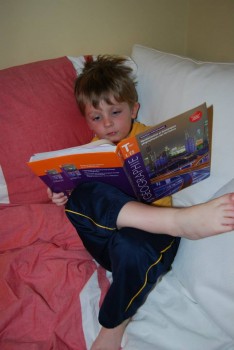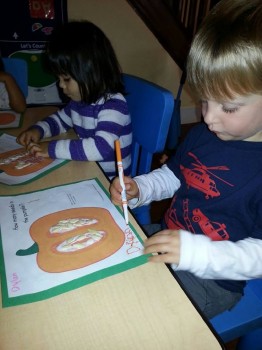 As a father of two toddlers (one 3 ½ years old and one just over 1 ½) I’m often amazed at their capacity for mindfulness. I’ve been saying that mindfulness will be the big wellness trend of the next decade. But it doesn’t come easily to most of us. In an increasingly fast-paced world fraught with information overload, our minds always seem to be pulled in different directions.
As a father of two toddlers (one 3 ½ years old and one just over 1 ½) I’m often amazed at their capacity for mindfulness. I’ve been saying that mindfulness will be the big wellness trend of the next decade. But it doesn’t come easily to most of us. In an increasingly fast-paced world fraught with information overload, our minds always seem to be pulled in different directions.
More and more, we recognize this as a flaw with our culture, and we seek out books, teachers, and meditative practices to help us learn how to be more mindful.
But my two sons don’t need to learn how to be mindful. They are always there, right in the moment. When they play, they are fully engaged in what they are doing, there is nothing else. When they get upset, they feel (and express) their emotions completely, with no filters and no reserve. But when the emotion passes, they let it go just as completely. And when they want to connect with their Mommy or Daddy, they will crawl into our laps, rest their heads against our bodies, and just absorb into the purest connection that any two humans can have.
When I observe this in my very young kids it makes me wonder if the secret to mindfulness is less about teaching adults how to practice it, and more about preventing children from unlearning it as they grow older.
Mindfulness experts will teach people to bring a “beginner’s mind” awareness to things. To see things as if for the first time. But kids truly have a beginner’s mind. Everything is new, and they have no preconceived biases or ideas.
But this is a case where experience gets in the way. We learn patterns, we develop expectations, we begin to ruminate about the past and worry about the future. And then decades later, we find ourselves in some mindfulness course trying to recapture that beginners mind that once defined us.
 I recently read a paper by two psychologists, Karen Hooker and Iris Fodor, who suggest that children can learn mindfulness practices to help them maintain their mindful state into their later years.
I recently read a paper by two psychologists, Karen Hooker and Iris Fodor, who suggest that children can learn mindfulness practices to help them maintain their mindful state into their later years.
Some examples of the recommended exercises are:
Awareness of an Object: The child practices drawing an object, paying close attention to details. Drawing the object a second time, they notice details they missed the first time around.
The Raisin Meditation: The child is invited to eat 3 raisins, approaching each one with curiosity, as if they have never seen a raisin before. They engage all the senses observing how the raisin looks, how it feels in the fingers and how it tastes.
Awareness of Movement: The child is instructed to move around the room as quietly as they can “as if walking on eggshells” being aware of every movement in the body.
These psychologists recommend having children practice mindfulness exercises as a way to improve psychological and emotional functioning as well as overall wellbeing. I think I’ll try this with my own kids. There’s some nice logic to having children practice mindfulness . . . while they can still remember what it feels like to be a beginner.
—
References and recommended reading:
Hooker, K. E. & Fodor, I. (2008). Teaching mindfulness to children. Gestalt Review, 12(1), 75-91.
by Jeremy McCarthy (@jeremymcc)
The PRINT version of my book is now available on Amazon!!!

Very nice Jeremy. Natural-born focus! What a concept. We are starting to see mindfulness appear in classrooms in some schools around the country. They don’t always start in pre-K, but they should be! Mindful Schools is tracking these developments: mindfulschools dot org
I think you are right about the increasing adoption of mindfulness as a wellness-creating practice that can help in many instances.
So true, Jeremy….perhaps remembering is the key – regaining that child-like focus. I have a hard time meditating, but going back to that two-year old brain is worth trying for. Burrowing back through the years to what it FELT like back then and holding on to that intensity. Thanks for the post – am passing it on to my daughter!
Lovely, Jeremy.
Some kids can’t do a raison, but a mini marshmallow works, especially if it is a bit stale. harder on the outside than inside. Great metaphor for so much of life.
How you see your kids as mindful and talk to them about it, how grand.
My son, Sean, will be 34 this week. He told me one of his lasting lessons about mindfulness and empathy was when he was 2. He was eating something, and our Benjy look-alike cock-a-poo-schnauzer, Stash, was mournfully watching him as he ate a snack. Aha! I asked him what it would be like for him if her were a dog. How he did not have freedom to go get a treat. What would that feel like? Sharing and empathy came pretty quickly after that.
So much of parenting hinges on US noticing our kids and reinforcing the values we see when we see them living those.
We DID need to talk to Sean about not feeding Stash too much after this, but he got the message!
Love that idea Judy. “What would life as a dog be like?” I will try that one too!
Love that doggy sharing made you smile, Jeremy!
Just wonderful. I’m sure children learn easily .
Rohit